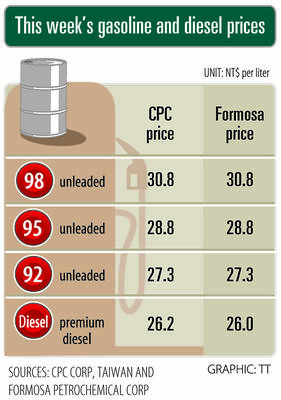The collapse in global oil prices might end up being bad news in the short term for the transition to green energy, as cheaper crude could see more use of road vehicles and aircraft. However, on the flip side, it could see companies move away from exploiting expensive fossil fuel deposits.
The plunging price of crude could prompt more people to use personal vehicles and airplanes rather than public transportation, and encourage the purchase of bigger, fuel-hungry models such as sport utility vehicles.
For individuals as well as businesses, a cheap barrel of crude also means cheaper heating oil, a slowdown in energy savings and could delay schemes to convert to “greener” electricity.

Photo: AP / General Motors
However, by reducing the profits of oil majors, cheap oil could see some potentially less profitable exploration projects put on hold, which would help cut future carbon emissions.
For example, that is particularly the case with shale oil in North America, which is costly to extract and is seen as not profitable at less than US$50 per barrel.
However, Greenpeace UK oil finance adviser Charlie Kronick said that it could also delay companies in their move toward becoming more environmentally friendly.
“In purely financial terms, cheap oil will make it easier for fossil fuels to compete with the increasingly affordable renewables, making the economic case for companies like BP [PLC] that are trying to reinvent themselves as greener energy producers more challenging, and potentially slowing the transition,” Kronick said.
“Expensive oil makes the alternatives, like electric vehicles, more attractive. Cheaper oil creates a headwind for that change,” he told reporters.
City, University of London’s Bobby Banerjee said that given the climate crisis and promises from a number of countries to achieve net-zero carbon emissions by 2050, investments in the sector were long-term.
“Oil prices always fluctuate, no government makes decisions on oil prices,” Banerjee said, adding that investment had already begun, helped by state subsidies that guarantee oil majors’ income.
Countries such as Britain are gradually closing all their coal-fired power stations.
The combined result has been that carbon dioxide emissions in the energy sector dropped 2 percent worldwide last year, data from independent energy think tank Ember showed.
Many businesses, notably investment funds, are also taking into account a high “carbon risk,” which has led the world’s biggest asset manager, Blackrock Inc, to pull its investments in coal.
All of these factors risk being supplanted in the short term by the COVID-19 pandemic, which has paralyzed the economies of several countries, grounded air traffic and, in the case of Italy, put the entire country into lockdown.
The demand for oil, especially from the world’s second-biggest consumer China, is in free fall. This should lower carbon dioxide emissions temporarily and even on a more sustainable basis if the effects of the coronavirus are as severe as the 2008 global financial crisis.
The situation is “a perfect opportunity to remove the subsidies to oil companies, because oil prices are low,” Banerjee said.
“It’s a good time to put the carbon tax very high to accelerate the energy transition,” he said.
However, given the likelihood of a looming economic slump, that could be politically problematic.
The transition to low-carbon energy is not dependent on the price or availability of fossil fuels, Kronick said.
“The shift is ultimately driven by the need to avoid catastrophic climate change and the inevitable economic disruption that comes with the climate emergency,” Kronick said.
“The shocks that we’re currently experiencing show that rapid changes are possible, though not always welcome. The economic conditions that we face now will pass, but the need to leave oil and gas in the ground won’t,” he said.
“The additional challenge is to make sure that the corresponding crisis in the oil markets doesn’t delay the low carbon transformation that we must begin now,” he added.

SETBACK: Apple’s India iPhone push has been disrupted after Foxconn recalled hundreds of Chinese engineers, amid Beijing’s attempts to curb tech transfers Apple Inc assembly partner Hon Hai Precision Industry Co (鴻海精密), also known internationally as Foxconn Technology Group (富士康科技集團), has recalled about 300 Chinese engineers from a factory in India, the latest setback for the iPhone maker’s push to rapidly expand in the country. The extraction of Chinese workers from the factory of Yuzhan Technology (India) Private Ltd, a Hon Hai component unit, in southern Tamil Nadu state, is the second such move in a few months. The company has started flying in Taiwanese engineers to replace staff leaving, people familiar with the matter said, asking not to be named, as the

The prices of gasoline and diesel at domestic fuel stations are to rise NT$0.1 and NT$0.4 per liter this week respectively, after international crude oil prices rose last week, CPC Corp, Taiwan (台灣中油) and Formosa Petrochemical Corp (台塑石化) announced yesterday. Effective today, gasoline prices at CPC and Formosa stations are to rise to NT$27.3, NT$28.8 and NT$30.8 per liter for 92, 95 and 98-octane unleaded gasoline respectively, the companies said in separate statements. The price of premium diesel is to rise to NT$26.2 per liter at CPC stations and NT$26 at Formosa pumps, they said. The announcements came after international crude oil prices

SinoPac Financial Holdings Co (永豐金控) is weighing whether to add a life insurance business to its portfolio, but would tread cautiously after completing three acquisitions in quick succession, president Stanley Chu (朱士廷) said yesterday. “We are carefully considering whether life insurance should play a role in SinoPac’s business map,” Chu told reporters ahead of an earnings conference. “Our priority is to ensure the success of the deals we have already made, even though we are tracking some possible targets.” Local media have reported that Mercuries Life Insurance Co (三商美邦人壽), which is seeking buyers amid financial strains, has invited three financial

CAUTION: Right now, artificial intelligence runs on faith, not productivity and eventually, the risk of a bubble will emerge,’ TIER economist Gordon Sun said Taiwanese manufacturers turned more optimistic last month, ending a five-month streak of declining sentiment as concerns over US tariffs, currency volatility and China’s overcapacity began to ease, the Taiwan Institute of Economic Research (TIER) said yesterday. The manufacturing business confidence index rose 1.17 points from June to 86.8, its first rebound since February. TIER economist Gordon Sun (孫明德) attributed the uptick to fading trade uncertainties, a steadier New Taiwan dollar and reduced competitive pressure from Chinese producers. Taiwan’s semiconductor industry is unlikely to face significant damage from Washington’s ongoing probe into semiconductors, given the US’ reliance on Taiwanese chips to power artificial